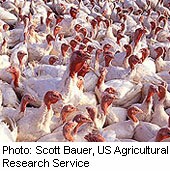
THURSDAY, June 6 (HealthDay News) — Genetic mutations in two emerging “bird” flu viruses could turn them into potential sources of pandemics, Massachusetts Institute of Technology researchers report.
One expert who was not involved with the new studies, however, said virus changes that may take place in the lab don’t necessarily translate to a real-world threat.
These two emerging flu strains, H5N1 and H7N9, originated in birds but as yet don’t spread easily to humans and aren’t transmitted from one person to another. However, that eventually might happen if the strains were to mutate in certain ways, the researchers said.
The two reports were published June 6 in the online edition of the journal Cell.
The studies looked at specific proteins found on the viruses.
“It is important to understand how the ‘bird flu’ H5N1 virus surface protein known as hemagglutinin (HA) is able to latch on to human [cellular] receptors in the upper lungs,” said Ram Sasisekharan, a distinguished professor of biological engineering at MIT.
This binding to human receptors is a necessary step that must occur before these viruses can spread from human to human, said Sasisekharan, the senior author of both new studies.
So far, neither H5N1 nor H7N9 has been able to efficiently bind to human receptors, Sasisekharan said.
“The H5N1 virus binds more readily to bird receptors, and a key question that we need to understand is [whether] the mutation is required in the HA protein to switch its receptor preference from bird to human,” Sasisekharan said. “We found that some of the strains require as little as one base pair change to switch its preference to human receptors.”
Although H5N1 has been evolving rapidly since 2005, none of the current strains has all of the mutations needed to spread from human to human, the researchers found.
Because of all the mutations that have occurred since 2005, the H5N1 vaccines that governments have stockpiled would probably no longer be effective, Sasisekharan said.
The virus went from birds to humans about 10 years ago and has infected nearly 600 people around the world, about 60 percent of whom have died, according to background information included in the study.
The study underscores the importance of carefully monitoring the evolution of H5N1 HA in the context of human adaptation, Sasisekharan said, because several strains have some key features needed for H5N1 to switch its receptor preference to humans.
H7N9 is another flu strain that could spread among people with simple mutations. This strain has infected at least 132 people this year, mostly in China, and 37 have died, according to the World Health Organization.
Given the rapid spread of H7N9 in China, it was important to understand how these viruses bind to human receptors, Sasisekharan said.
“We found that the virus binding to human receptor was poor,” he said. “However, a change in a single amino acid was enough to significantly increase its binding to human receptors.”
This is a rapidly evolving virus and it will be critical to monitor how it might adapt to humans — especially how it might transmit from human to human, he said.
H7 flu typically circulates only in animals, so most people would not have an immune response against it, Sasisekharan said. There are some H7 vaccines in development, but the strains used to create these vaccines are different from H7N9 and likely would not provide any protection from this strain.
“In that context, understanding and monitoring mutations in H7N9 that leads to better human receptor binding will be key,” Sasisekharan said.
One expert, however, doesn’t think it’s likely that the genetic changes the researchers produced in the laboratory will occur in nature.
“You can make these genetic changes in the lab, but it still doesn’t make these viruses go easily from human to human,” said Dr. Marc Siegel, an associate professor of medicine at NYU Langone Medical Center in New York City. “No matter what you manipulate in the test tube you can’t predict all the exact factors in nature.”
Science is learning what mutations it would take to make these deadly viruses spread among people, Siegel said. “This is not the same thing as saying these mutations will occur naturally,” he said.
Siegel noted that these flu strains have not been the cause of flu pandemics in the past.
“There is probably a genetic reason why all human flu pandemics have been H1, H2 and H3 strains and not H5 and H7,” he said.
“It’s really unlikely that these mutations will occur naturally in either of these viruses,” Siegel said. “People should be reassured that scientists are studying this.”
More information
For more about the flu, visit the U.S. Centers for Disease Control and Prevention.

